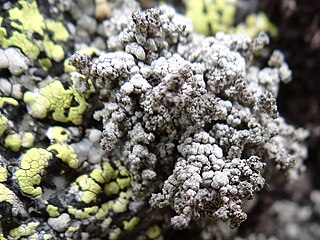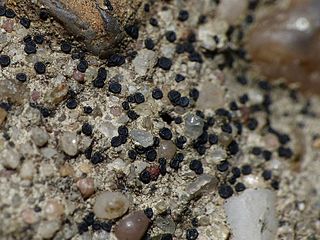Geltingia is a fungal genus in the family Helicogoniaceae. It is monotypic, containing the single lichenicolous species Geltingia associata. The genus was circumscribed in 1990 by mycologists Vagn Alstrup and David Leslie Hawksworth. The genus name honours Danish scientist Paul Gelting.

Lecanora polytropa, the granite-speck rim lichen, is a species of saxicolous (rock-dwelling), crustose lichen in the family Lecanoraceae. A small, inconspicuous species that grows in the cracks of rock surfaces, it has a cosmopolitan distribution and has been recorded on all continents, including Antarctica.

Stereocaulon alpinum is a species of fungus belonging to the family Stereocaulaceae. It is similar to Stereocaulon paschale but differs from it in containing cyanobacteria of the genus Nostoc while S. paschale contains cyanobacteria of the genus Stigonema, which have a darker colour than Nostoc.

Lichenoconium pyxidatae is a species of lichenicolous fungus belonging to the class Dothideomycetes. It has a Holarctic distribution being found in Alaska and various parts of Russia, including Siberia, Franz Josef Land, Novaya Zemlya and Wrangel Island.
Didymocyrtis trassii is a species of lichenicolous (lichen-eating) fungus in the family Phaeosphaeriaceae. It is found in southern Ukraine, where it parasitises the foliose lichen Cetraria aculeata growing on sand dunes.
Buelliella lecanorae is a species of lichenicolous (lichen-eating) fungus in the class Dothideomycetes. It is found in a few locations in Estonia and in Crimea, where it grows parasitically on members of the Lecanora subfusca species group.
Lichenopeltella coppinsii is a species of lichenicolous fungus belonging to the class Dothideomycetes. It was described in 1999. It is known to infect Verrucaria muralis and has been reported from the British Isles, Ukraine, and Moshchny Island in the Baltic sea.

Stereocaulon vesuvianum is a species of snow lichen belonging to the family Stereocaulaceae.
Stereocaulon glareosum is a species of snow lichen belonging to the family Stereocaulaceae.
Stereocaulon rivulorum is a species of snow lichen belonging to the family Stereocaulaceae.
Cercidospora stereocaulorum is a species of lichenicolous fungus in the genus Cercidospora but it has not been assigned to a family. It is known to parasitise lichens of the genus Stereocaulon.
Sphaerellothecium araneosum is a species of lichenicolous fungus in the family Phyllachoraceae.
Polycoccum laursenii is a species of lichenicolous fungus in the family Polycoccaceae. It was first described as a new species in 2004 by Russian mycologist Mikhail Petrovich Zhurbenko. It is found in Alaska and in Russia.
Halospora is a genus of lichenicolous (lichen-dwelling) fungi in the family Verrucariaceae. Species in the genus parasitise calcicolous crustose lichens, i.e., those that prefer lime-rich substrates.
Arthonia stereocaulina is a species of lichenicolous fungus in the family Arthoniaceae.

Verrucaria muralis is a species of saxicolous (rock-dwelling, crustose lichen in the family Verrucariaceae. It is a common species with an almost cosmopolitan distribution, occurring in an altitudinal range extending from the lowlands to the subalpine zone. It grows on calcareous rocks and walls. It was first formally described as a new species in 1803 by Swedish lichenologist Erik Acharius.
Carbonea aggregantula is a species of lichenicolous (lichen-dwelling) fungus belonging to the family Lecanoraceae.
Scutula stereocaulorum is a species of lichenicolous fungus in the family Ramalinaceae.
Lecanora perpruinosa is a species of saxicolous (rock-dwelling), crustose lichen in the family Lecanoraceae. It occurs in Northern Europe, Estonia, Turkey, Russia, and Canada, where it grows on calcareous rocks.
Sphaerellothecium gowardii is a species of lichenicolous (lichen-dwelling) fungus in the family Phyllachoraceae. It was formally described as a new species in 1998 by Vagn Alstrup and Mariette Cole. The type specimen was collected by Alstrup from the Valleyview silt cliffs in Kamloops, British Columbia, Canada at an elevation of 450 m (1,480 ft), where it was found growing on Acarospora schleicheri. The fungus is parasymbiotic or weakly symbiotic on its lichen host. The species epithet honours the Canadian lichenologist Trevor Goward, who helped organise the August 1994 excursion in which this and several other lichenicolous fungi were discovered.




